Reconstruction of Past Water Levels in Data-Deficient Karst Springs
Abstract
:1. Introduction
2. Study Area and Methods
2.1. Study Area
2.2. Model Description
2.3. Data Preparation
2.4. Model Development
3. Results and Discussion
3.1. Reconstructed Groundwater Level Changes
3.2. Verification of Model Results
3.3. Establishment of a Management Tool
3.4. Limitation of the Study
4. Conclusions
Author Contributions
Funding
Data Availability Statement
Conflicts of Interest
References
- Stevanović, Z. Karst waters in potable water supply: A global scale overview. Environ. Earth Sci. 2019, 78, 662. [Google Scholar] [CrossRef]
- Li, Z.W.; Xu, X.L.; Liu, M.X.; Li, X.Z.; Zhang, R.F.; Wang, K.L.; Xu, C.H. State-space prediction of spring discharge in a karst catchment in southwest China. J. Hydrol. 2017, 549, 264–276. [Google Scholar] [CrossRef]
- Scott, T.M. Florida’s springs in jeopardy. Geotimes 2002, 47, 16–20. [Google Scholar]
- Stevanović, S.D.; Krstić, J.N.; Stojanović, B.T.; Paunović, D.Đ.; Dimitrijević, D.S.; Veličković, J.M.; Stanković, N.J. Monitoring of drinking water from the karst springs of the Ljuberadja-Ni water supply system (Serbia). SN Appl. Sci. 2020, 2, 1847. [Google Scholar] [CrossRef]
- Olarinoye, T.; Gleeson, T.; Marx, V.; Seeger, S.; Adinehvand, R.; Allocca, V.; Andreo, B.; Apaéstegui, J.; Apolit, C.; Arfib, B.; et al. Global karst springs hydrograph dataset for research and management of the world’s fastest-flowing groundwater. Sci. Data 2020, 7, 59. [Google Scholar] [CrossRef] [PubMed]
- Benischke, R. Review: Advances in the methodology and application of tracing in karst aquifers. Hydrogeol. J. 2021, 29, 67–88. [Google Scholar] [CrossRef]
- Nerantzaki, S.D.; Nikolaidis, N.P. The response of three Mediterranean karst springs to drought and the impact of climate change. J. Hydrol. 2020, 591, 125296. [Google Scholar] [CrossRef]
- Fiorillo, F.; Leone, G.; Pagnozzi, M.; Esposito, L. Long-term trends in karst spring discharge and relation to climate factors and changes. Hydrogeol. J. 2021, 29, 347–377. [Google Scholar] [CrossRef]
- Kovács, A.; Perrochet, P.; László, K.; Jeannin, P.Y. A quantitative method for the characterisation of karst aquifers based on spring hydrograph analysis. J. Hydrol. 2005, 303, 152–164. [Google Scholar] [CrossRef]
- Filippini, M.; Squarzoni, G.; Waele, J.; Fiorucci, A.; Vigna, B.; Grillo, B.; Riva, A.; Rossetti, S.; Zini, L.; Giacomo, G.; et al. Differentiated spring behavior under changing hydrological conditions in an alpine karst aquifer. J. Hydrol. 2018, 556, 572–584. [Google Scholar] [CrossRef]
- Yang, M.; Yaquian, J.A.; Annable, M.D.; Jawitz, J.W. Karst conduit contribution to spring discharge and aquifer cross-sectional area. J. Hydrol. 2019, 578, 124037. [Google Scholar] [CrossRef]
- Moore, P.J.; Martin, J.B.; Screaton, E.J. Geochemical and statistical evidence of recharge, mixing, and controls on spring discharge in an eogenetic karst aquifer. J. Hydrol. 2009, 376, 443–455. [Google Scholar] [CrossRef]
- Pratama, A.D.; Dwiputra, D.S.; Nurkholis, A.; Haryono, E.; Cahyadi, A.; Agniy, R.F.; Adji, T.N. Factors affecting hydrochemistry of karst springs and their relationship to aquifer development. Environ. Process. 2021, 8, 1379–1413. [Google Scholar] [CrossRef]
- Knöll, P.; Zirlewagen, J.; Scheytt, T. Using radar-based quantitative precipitation data with coupled soil- and groundwater balance models for stream flow simulation in a karst area. J. Hydrol. 2020, 586, 124884. [Google Scholar] [CrossRef]
- Al-Halbouni, D.; Watson, R.; Holohan, E.; Meyer, R.; Polom, U.; Dos Santos, F.M.D.; Comas, X.; Alrshdan, H.; Krawczyk, C.; Dahm, T. Dynamics of hydrological and geomorphological processes in evaporite karst at the eastern Dead Sea—A multidisciplinary study. Hydrol. Earth Syst. Sci. 2021, 25, 3351–3395. [Google Scholar] [CrossRef]
- Sen, Z. General modeling of karst spring hydrographs and development of a dimensionless karstic hydrograph concept. Hydrogeol. J. 2020, 28, 549–559. [Google Scholar] [CrossRef]
- Hartmann, A.; Baker, A. Modelling karst vadose zone hydrology and its relevance for paleoclimate reconstruction. Earth-Sci. Rev. 2017, 172, 178–192. [Google Scholar] [CrossRef]
- Sun, J.C.; Hu, L.T.; Chen, F.; Sun, K.N.; Yu, L.L.; Liu, X. Downscaling simulation of groundwater storage in the Beijing, Tianjin, and Hebei regions of China based on GRACE data. Remote Sens. 2023, 15, 1490. [Google Scholar] [CrossRef]
- Mangiarotti, S.; Zhang, Y.; Leblanc, M. Chaos theory applied to the modelling of karst springs: First results from univariate time series. Hydrogeol. J. 2019, 27, 2027–2043. [Google Scholar] [CrossRef]
- Hu, C.H.; Hao, Y.H.; Yeh, T.C.J.; Pang, B.; Wu, Z.N. Simulation of spring flows from a karst aquifer with an artificial neural network. Hydrol. Process. 2008, 22, 596–604. [Google Scholar] [CrossRef]
- Nhu, V.H.; Rahmati, O.; Falah, F.; Shojaei, S.; AI-Ansari, N.; Shahabi, H.; Shirzadi, A.; Górski, K.; Nguyen, H.; Bin Ahmad, B. Mapping of groundwater spring potential in karst aquifer system using novel ensemble bivariate and multivariate models. Water 2020, 12, 985. [Google Scholar] [CrossRef]
- Song, X.H.; Hao, H.Q.; Liu, W.Q.; Wang, Q.; An, L.X.; Yeh, T.C.J.; Hao, Y.H. Spatial-temporal behavior of precipitation driven karst spring discharge in a mountain terrain. J. Hydrol. 2022, 612, 128116. [Google Scholar] [CrossRef]
- Basu, B.; Morrissey, P.; Gill, L. Application of nonlinear time series and machine learning algorithms for forecasting groundwater flooding in a lowland karst area. Water Resour. Res. 2022, 58, e2021WR029576. [Google Scholar] [CrossRef]
- Sepúlveda, N.; Tiedeman, C.R.; O’Reilly, A.M.; Davis, J.B.; Patrick, B. Groundwater Flow and Water Budget in the Surficial and Floridan Aquifer Systems in East-Central Florida; U.S. Geological Survey Scientific Investigations Report 2012–5161; U.S. Geological Survey: Reston, VI, USA, 2012; 214p.
- Eisenlohr, L.; Kiraly, L.; Bouzelboudjen, M.; Rossier, Y. Numerical simulation as a tool for checking the interpretation of karst spring hydrographs. J. Hydrol. 1997, 193, 306–315. [Google Scholar] [CrossRef]
- Birk, S.; Liedl, R.; Sauter, M. Karst spring responses examined by process-based modeling. Ground Water 2006, 44, 832–836. [Google Scholar] [CrossRef] [PubMed]
- Geyer, T.; Birk, S.; Liedl, R.; Sauter, M. Quantification of temporal distribution of recharge in karst systems from spring hydrographs. J. Hydrol. 2008, 348, 452–463. [Google Scholar] [CrossRef]
- Butscher, C.; Huggenberger, P. Intrinsic vulnerability assessment in karst areas: A numerical modeling approach. Water Resour. Res. 2008, 44, 2007WR006277. [Google Scholar] [CrossRef]
- Scanlon, B.R.; Mace, R.E.; Barrett, M.B.; Smith, B. Can we simulate regional groundwater flow in a karst system using equivalent porous media models? Case study, Barton Springs Edwards aquifer, USA. J. Hydrol. 2003, 276, 137–158. [Google Scholar] [CrossRef]
- Fleury, P.; Ladouche, B.; Conroux, Y.; Jourde, H.; Dörfliger, N. Modelling the hydrologic functions of a karst aquifer under active water management–the Lez spring. J. Hydrol. 2009, 365, 235–243. [Google Scholar] [CrossRef]
- Beijing Institute of Geology; Beijing Institute of Geo-Environment Monitoring. Monograph on the Springs in the Beijing Area; Geological Publishing House: Beijing, China, 2022. (In Chinese) [Google Scholar]
- Sun, K.N.; Hu, L.T.; Guo, J.L.; Yang, Z.Q.; Zhai, Y.Z.; Zhang, S.Q. Enhancing the understanding of hydrological responses induced by ecological water replenishment using improved machine learning models: A case study in the Yongding River. Sci. Total Environ. 2021, 768, 145489. [Google Scholar] [CrossRef]
- Sun, K.N.; Hu, L.T.; Sun, J.C.; Zhai, Y.Z.; Zhang, S.Q.; Cao, X.Y. Quantifying the contribution of ecological water replenishment on aquifer recovery using a refined groundwater model. Sci. Total Environ. 2023, 857, 159216. [Google Scholar] [CrossRef]
- Wang, L.J.; Zhang, Y.Q.; Gong, H.L.; Yang, G.Q.; Liu, J.R.; Sun, Y. A study on recovery condition of Yuquanshan spring in Beijing. Hydrogeol. Eng. Geol. 2016, 43, 22–28, (In Chinese with English Abstract). [Google Scholar]
- Qin, D.J.; Sun, J.; Guo, Y.; Liu, L.; Mohammed, H.; Wang, D.D.; Liu, W.C. Impacts of Yongding River on the Xishan karst aquifer and Yuquan spring in Beijing, China. J. Eng. Geol. 2019, 27, 162–169, (In Chinese with English Abstract). [Google Scholar]
- Shen, Y.Y.; Guo, G.X.; Ou, Z.L.; Xin, B.D.; Nan, Y.H.; Wang, L.Y.; Wang, S.F.; Liu, J.R. Recovery scheme of Yuquanshan spring in Beijing. South-North Water Transf. Water Sci. Technol. 2021, 19, 645–655, (In Chinese with English Abstract). [Google Scholar]
- Li, G.H.; Pan, X.Y.; Li, B.H.; Yang, Y.; Yang, M.Y.; Zhang, D.; OUYang, Y. Study on the Ecological Replenishment of Yongding River (Beijing Section) to Yuquan Mountain Spring in Autumn. J. China Hydrol. 2023, 43, 30–34, (In Chinese with English Abstract). [Google Scholar]
- Zhao, C.H.; Liang, Y.P.; Wang, W.T.; Tang, C.L.; Shen, H.Y. Discussion on the characteristics of karst water systems in the Xishan area of Beijing. Carsologica Sin. 2017, 36, 641–647, (In Chinese with English Abstract). [Google Scholar]
- Hu, L.; Wang, Z.J.; Tian, W.; Zhao, J.S. Coupled surface water–groundwater model and its application in the arid Shiyang River basin, China. Hydrol. Process. 2010, 23, 2033–2044. [Google Scholar] [CrossRef]
- Civita, M.V. An improved method for delineating source protection zones for karst springs based on analysis of recession curve data. Hydrogeol. J. 2008, 16, 855–869. [Google Scholar] [CrossRef]
- Daher, W.; Pistre, S.; Kneppers, A.; Najem, W. Karst and artificial recharge: Theoretical and practical problems: A preliminary approach to artificial recharge assessment. J. Hydrol. 2011, 408, 189–202. [Google Scholar] [CrossRef]
- Sun, J.C.; Hu, L.T.; Li, D.D.; Sun, K.N.; Yang, Z.Q. Data-driven models for accurate groundwater level prediction and their practical significance in groundwater management. J. Hydrol. 2022, 608, 127630. [Google Scholar] [CrossRef]
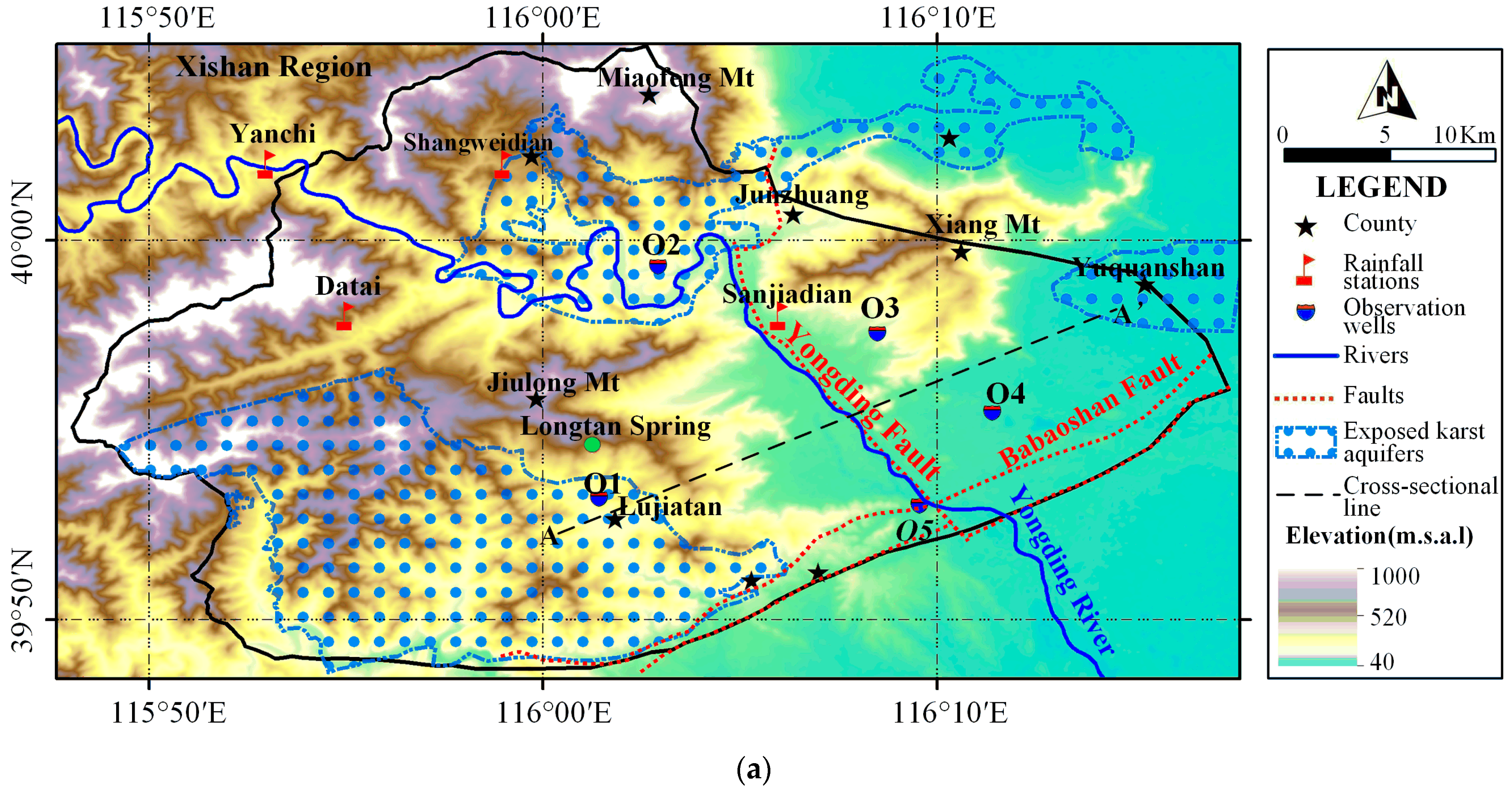
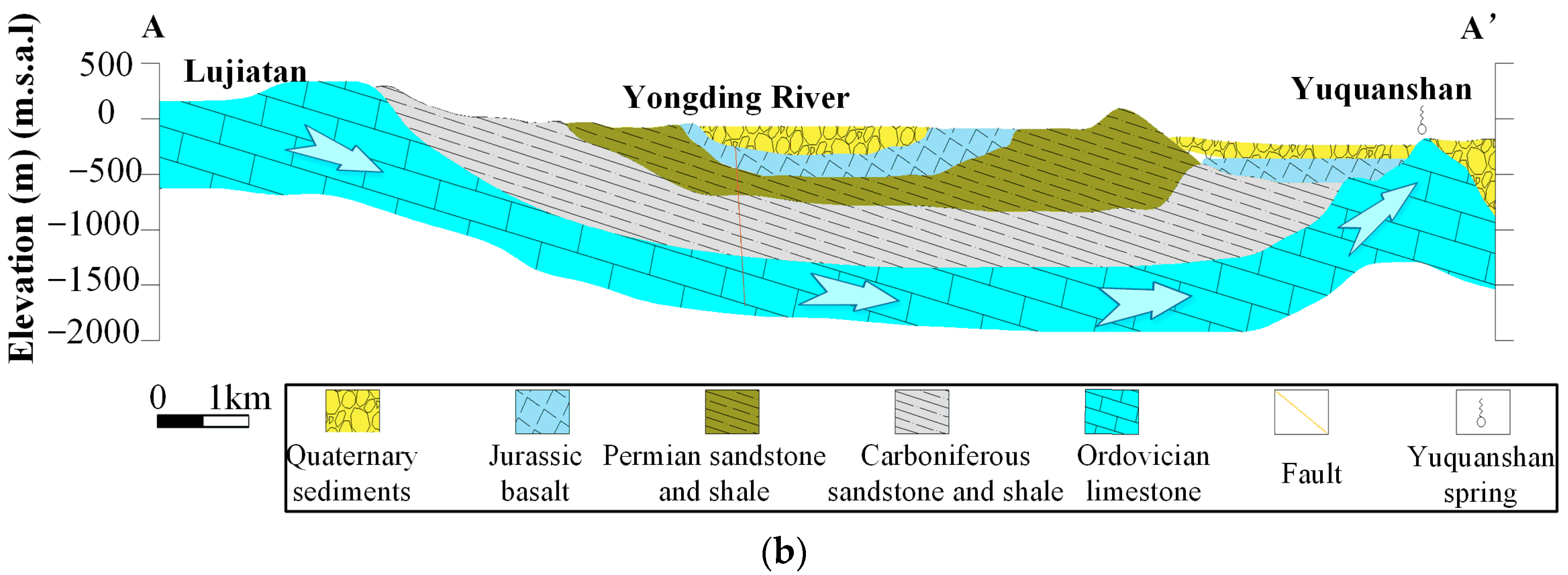
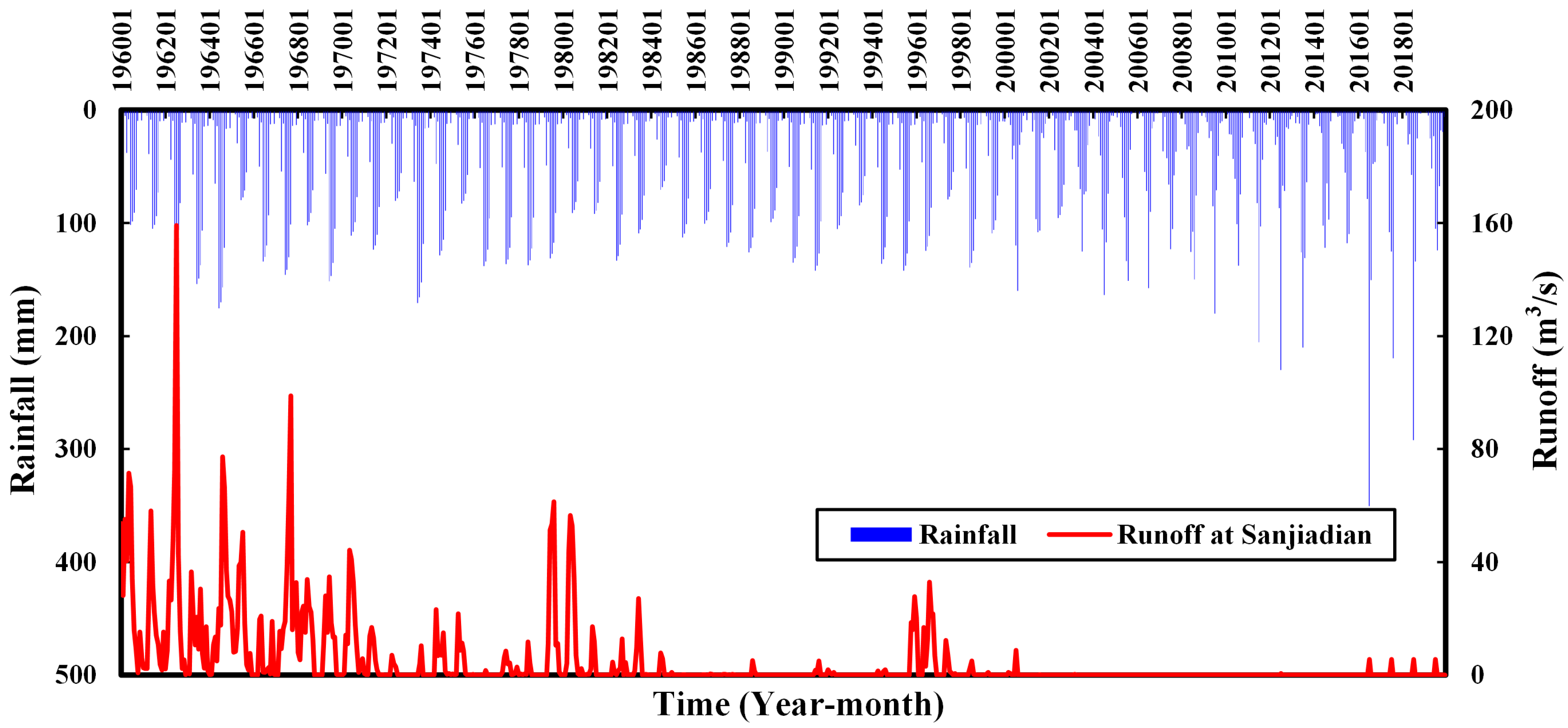


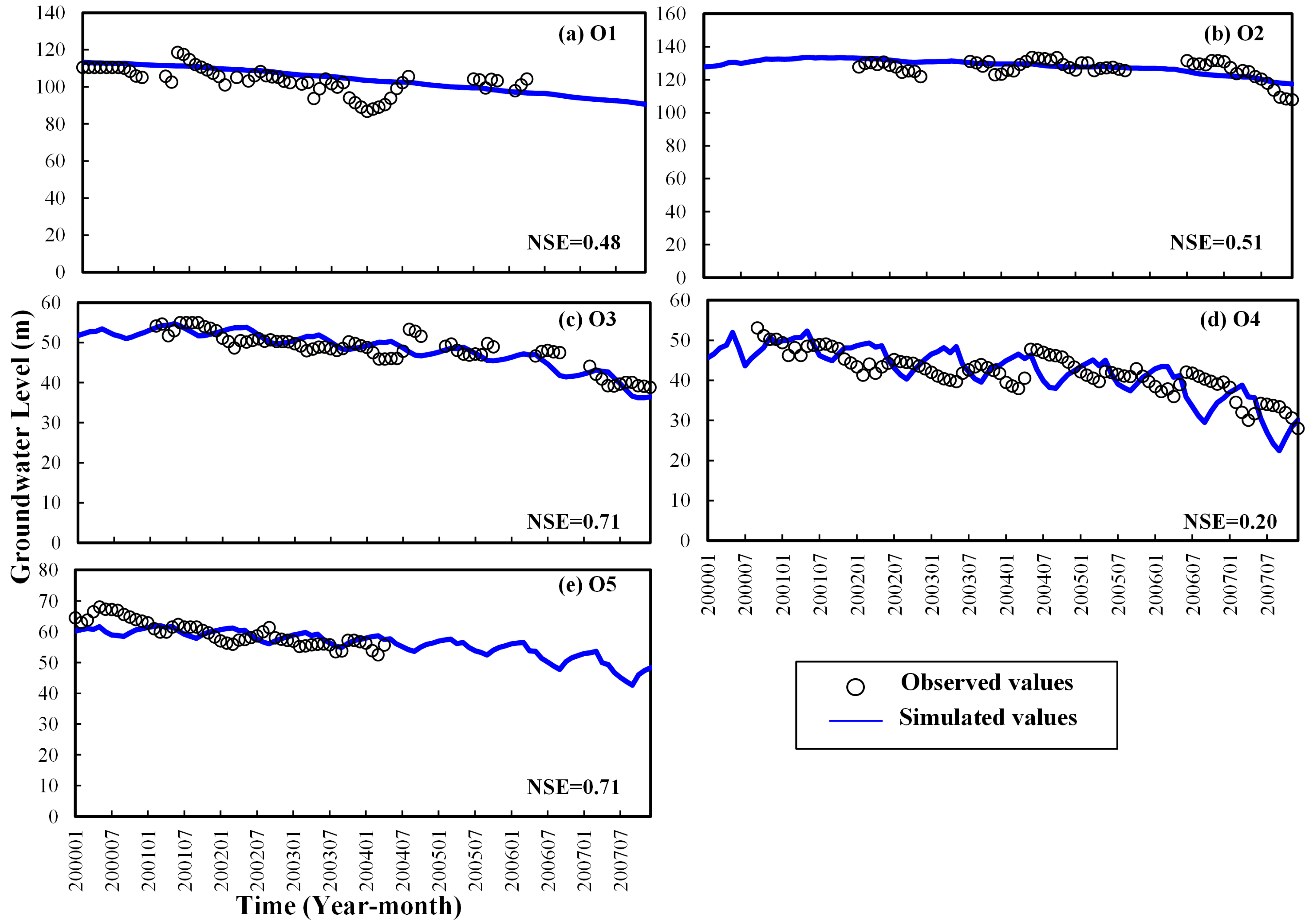
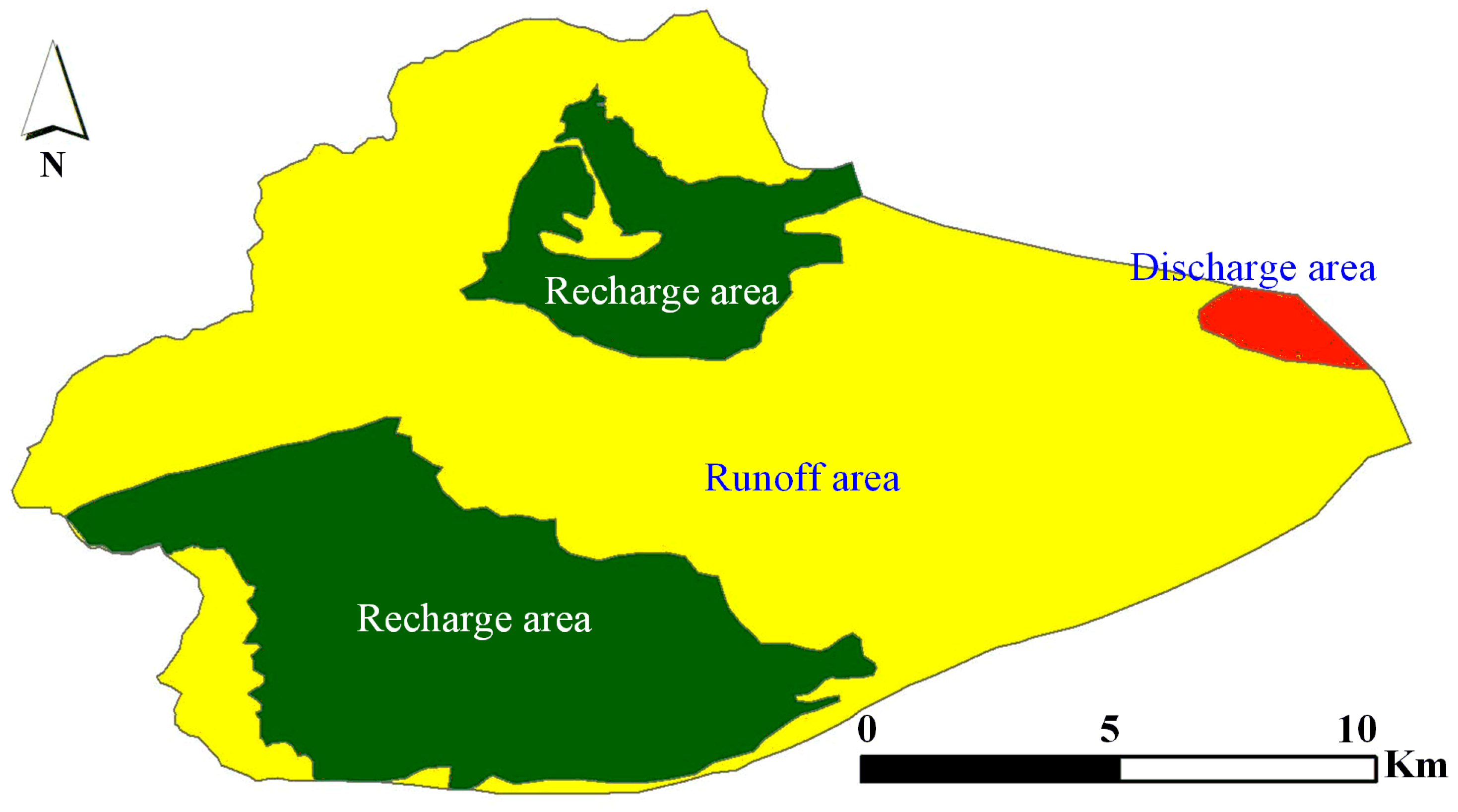

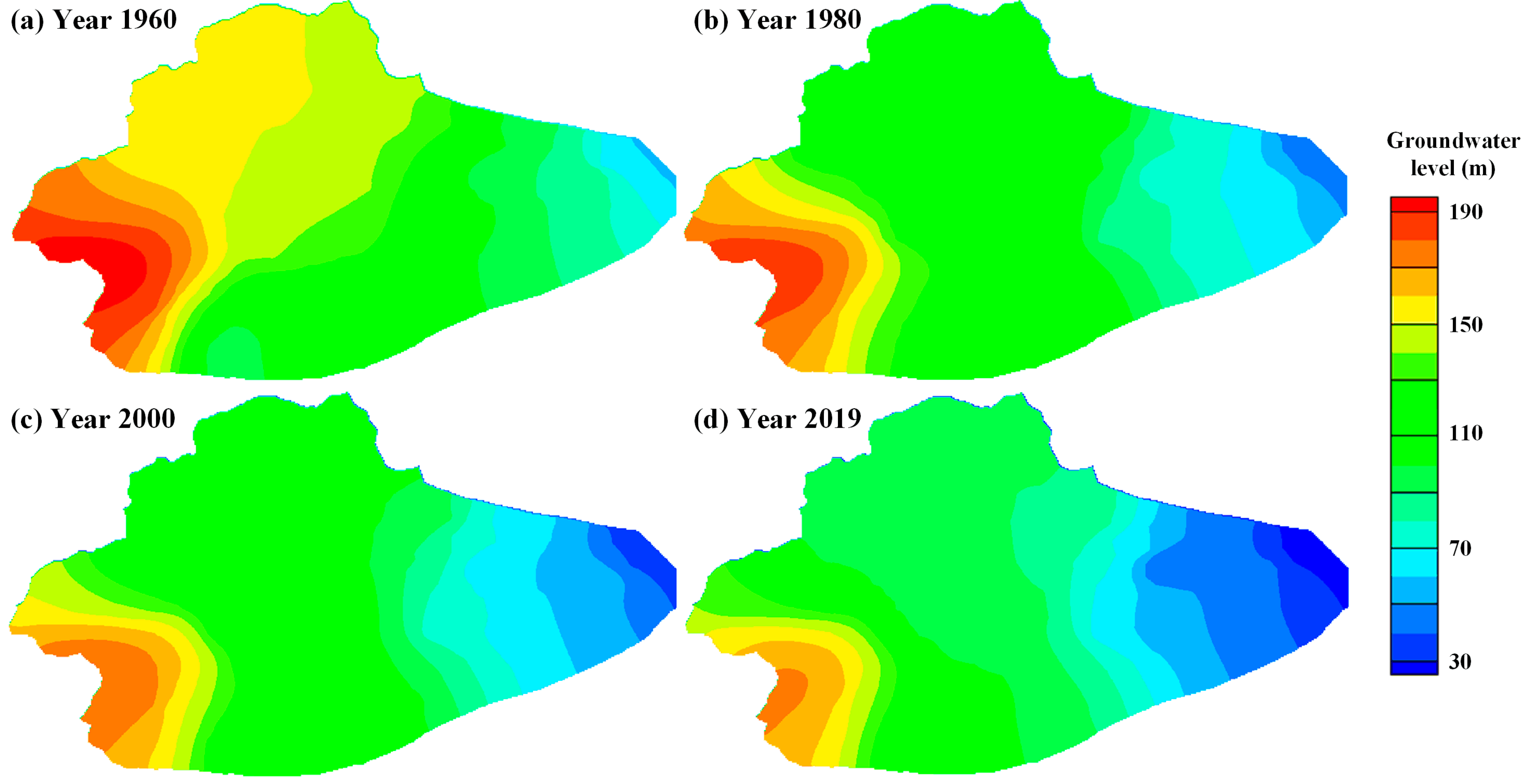

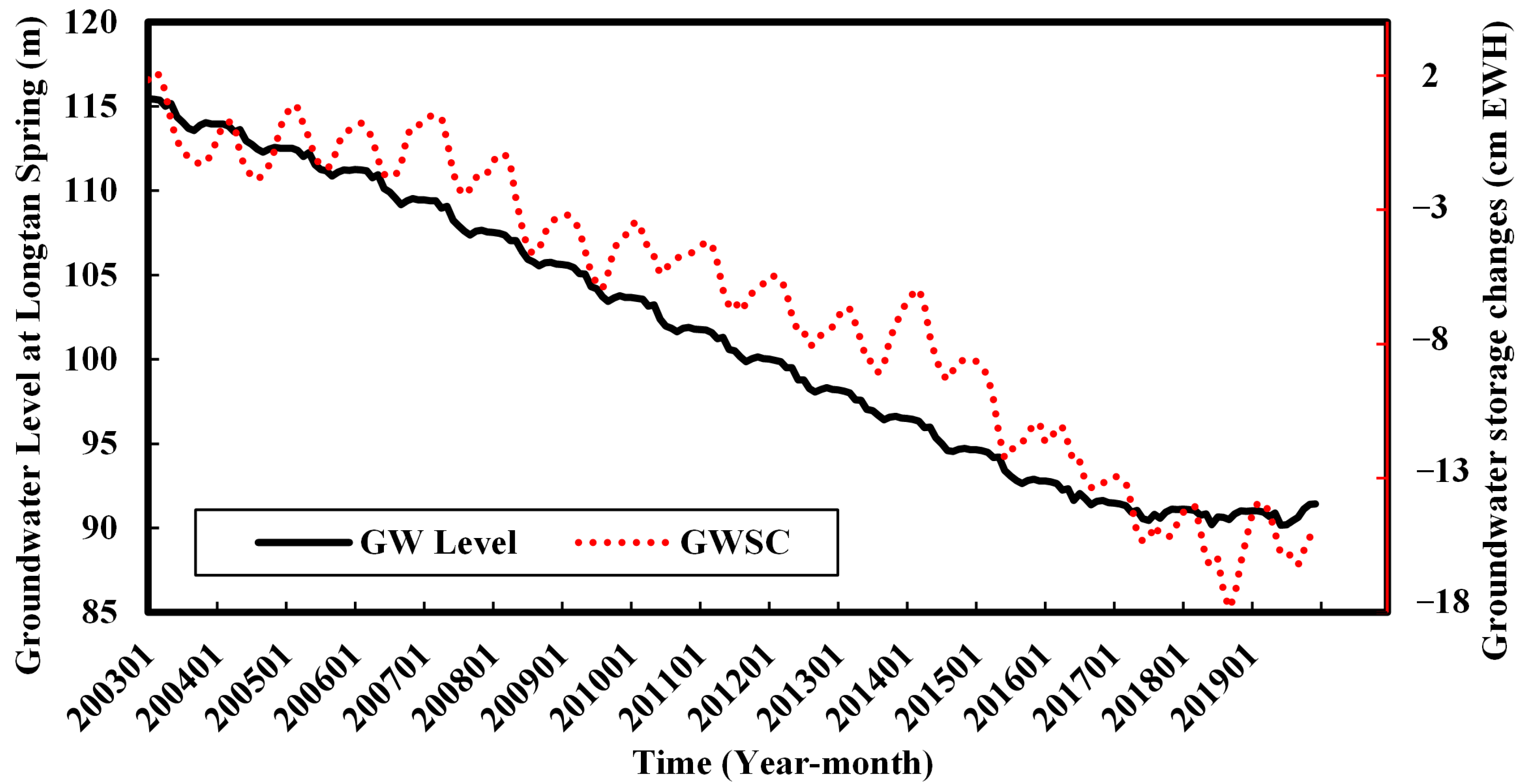

| Data Types | Data Description | Data Sources |
|---|---|---|
| Borehole logging and karst aquifer information | 10 wells | Open reports from Beijing Institute of Geology |
| Rainfall | 5 stations, 1956–2019 | China Meteorological Administration |
| Groundwater withdrawal | The whole area, 2000–2007 | Open reports from Beijing Water Authority |
| Observations | 5 wells, 2000–2007 1 well, 1960–2019 | Open reports from Beijing Institute of Geology |
| Streamflow | Sanjiadian station, 1956–2019 | Open reports from Beijing Water Authority |
| Groundwater storage | The whole area at the spatial resolution of 5 km, 2003–2019 | [18] |
| Zone Number | Hydraulic Conductivities (m/d) | Storativity (m−1) | Specific Yield (Dimensionless) | Zone Number | Hydraulic Conductivities (m/d) | Storativity (m−1) | Specific Yield (Dimensionless) |
|---|---|---|---|---|---|---|---|
| 1 | 0.20 | 0.000003 | 0.05 | 16 | 5.00 | 0.00005 | 0.15 |
| 2 | 0.20 | 0.000008 | 0.05 | 17 | 2.50 | 0.00008 | 0.15 |
| 3 | 0.50 | 0.000003 | 0.05 | 18 | 3.00 | 0.000004 | 0.15 |
| 4 | 0.30 | 0.000005 | 0.05 | 19 | 4.00 | 0.00001 | 0.15 |
| 5 | 1.00 | 0.000005 | 0.10 | 20 | 0.50 | 0.000004 | 0.20 |
| 6 | 5.00 | 0.000008 | 0.10 | 21 | 2.00 | 0.000008 | 0.20 |
| 7 | 0.50 | 0.000008 | 0.10 | 22 | 5.00 | 0.000009 | 0.20 |
| 8 | 0.50 | 0.000009 | 0.10 | 23 | 7.50 | 0.000005 | 0.21 |
| 9 | 10.00 | 0.000015 | 0.10 | 24 | 5.00 | 0.00005 | 0.21 |
| 10 | 2.00 | 0.000005 | 0.10 | 25 | 0.50 | 0.00005 | 0.21 |
| 11 | 2.00 | 0.000008 | 0.10 | 26 | 9.00 | 0.000003 | 0.22 |
| 12 | 1.50 | 0.000008 | 0.15 | 27 | 15.00 | 0.00002 | 0.23 |
| 13 | 2.50 | 0.000008 | 0.15 | 28 | 5.00 | 0.000008 | 0.26 |
| 14 | 2.50 | 0.00001 | 0.15 | 29 | 15.00 | 0.000008 | 0.27 |
| 15 | 5.00 | 0.00002 | 0.15 | 30 | 20.00 | 0.000007 | 0.28 |
Disclaimer/Publisher’s Note: The statements, opinions and data contained in all publications are solely those of the individual author(s) and contributor(s) and not of MDPI and/or the editor(s). MDPI and/or the editor(s) disclaim responsibility for any injury to people or property resulting from any ideas, methods, instructions or products referred to in the content. |
© 2024 by the authors. Licensee MDPI, Basel, Switzerland. This article is an open access article distributed under the terms and conditions of the Creative Commons Attribution (CC BY) license (https://creativecommons.org/licenses/by/4.0/).
Share and Cite
Wen, C.; Li, J.; Sun, D.; Zhang, Y.; Zhao, N.; Hu, L. Reconstruction of Past Water Levels in Data-Deficient Karst Springs. Water 2024, 16, 1150. https://doi.org/10.3390/w16081150
Wen C, Li J, Sun D, Zhang Y, Zhao N, Hu L. Reconstruction of Past Water Levels in Data-Deficient Karst Springs. Water. 2024; 16(8):1150. https://doi.org/10.3390/w16081150
Chicago/Turabian StyleWen, Chunyan, Jizhen Li, Dandan Sun, Yanwei Zhang, Naifeng Zhao, and Litang Hu. 2024. "Reconstruction of Past Water Levels in Data-Deficient Karst Springs" Water 16, no. 8: 1150. https://doi.org/10.3390/w16081150





